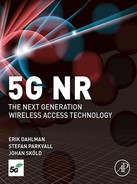Abbreviations and Acronyms
3GPP Third Generation Partnership Project
ACIR Adjacent Channel Interference Ratio
ACK Acknowledgment (in ARQ protocols)
ACLR Adjacent Channel Leakage Ratio
ACS Adjacent Channel Selectivity
ADC Analog-to-Digital Converter
AM Acknowledged Mode (RLC configuration)
AMF Access and Mobility Management Function
A-MPR Additional Maximum Power Reduction
AMPS Advanced Mobile Phone System
ARI Acknowledgment Resource Indicator
ARIB Association of Radio Industries and Businesses
ATIS Alliance for Telecommunications Industry Solutions
AUSF Authentication Server Function
AWGN Additive White Gaussian Noise
BCCH Broadcast Control Channel
BiCMOS Bipolar Complementary Metal Oxide Semiconductor
BPSK Binary Phase-Shift Keying
CACLR Cumulative Adjacent Channel Leakage Ratio
CCSA China Communications Standards Association
CDM Code Division Multiplexing
CDMA Code-Division Multiple Access
CEPT European Conference of Postal and Telecommunications Administration
CITEL Inter-American Telecommunication Commission
C-MTC Critical Machine-Type Communications
CMOS Complementary Metal Oxide Semiconductor
CoMP Coordinated Multi-Point Transmission/Reception
C-RNTI Cell Radio-Network Temporary Identifier
CS Capability Set (for MSR base stations)
CSI-IM CSI Interference Measurement
CS-RNTI Configured scheduling RNTI
DAC Digital-to-Analog Converter
DCCH Dedicated Control Channel
DCI Downlink Control Information
DFT Discrete Fourier Transform
DFTS-OFDM DFT-Spread OFDM (DFT-precoded OFDM, see also SC-FDMA)
DL-SCH Downlink Shared Channel
DM-RS Demodulation Reference Signal
DTX Discontinuous Transmission
EDGE Enhanced Data Rates for GSM Evolution, Enhanced Data Rates for Global Evolution
ECC Electronic Communications Committee (of CEPT)
eIMTA Enhanced Interference Mitigation and Traffic Adaptation
EIRP Effective Isotropic Radiated Power
EIS Equivalent Isotropic Sensitivity
EN-DC E-UTRA NR Dual-Connectivity
ETSI European Telecommunications Standards Institute
FCC Federal Communications Commission
FDM Frequency Division Multiplexing
FDMA Frequency-Division Multiple Access
FPLMTS Future Public Land Mobile Telecommunications Systems
GERAN GSM/EDGE Radio Access Network
GSA Global mobile Suppliers Association
GSM Global System for Mobile Communications
HBT Heterojunction Bipolar Transistor
HEMT High Electron-Mobility Transistor
ICNIRP International Commission on Non-Ionizing Radiation
IEEE Institute of Electrical and Electronics Engineers
IFFT Inverse Fast Fourier Transform
IMD Inter Modulation Distortion
IMT-2000 International Mobile Telecommunications 2000 (ITU’s name for the family of 3G standards)
IMT-2020 International Mobile Telecommunications 2020 (ITU’s name for the family of 5G standards)
IMT-Advanced International Mobile Telecommunications Advanced (ITU’s name for the family of 4G standards)
InGaP Indium Gallium Phosphide
ITRS International Telecom Roadmap for Semiconductors
ITU International Telecommunications Union
ITU-R International Telecommunications Union-Radiocommunications Sector
L1-RSRP Layer 1 Reference Signal Receiver Power
LDPC Low-Density Parity Check Code
LTCC Low Temperature Co-fired Ceramic
MB-MSR Multi-Band Multi Standard Radio (base station)
MCS Modulation and Coding Scheme
MMIC Monolithic Microwave Integrated Circuit
MIMO Multiple-Input Multiple-Output
mMTC massive Machine Type Communication
MTC Machine-Type Communication
NAK Negative Acknowledgment (in ARQ protocols)
NB-IoT Narrow-Band Internet-of-Things
NG The interface between the gNB and the 5G CN
NG-c The control-plane part of NG
NGMN Next Generation Mobile Networks
NG-u The user-plane part of NG
NMT Nordisk MobilTelefon (Nordic Mobile Telephony)
NodeB NodeB, a logical node handling transmission/reception in multiple cells. Commonly, but not necessarily, corresponding to a base station
NOMA Nonorthogonal Multiple Access
NZP-CSI-RS Non-zero-power CSI-RS
OBUE Operating Band Unwanted Emissions
OFDM Orthogonal Frequency-Division Multiplexing
OSDD OTA Sensitivity Direction Declarations
PAPR Peak-to-Average Power Ratio
PAR Peak-to-Average Ratio (same as PAPR)
PBCH Physical Broadcast Channel
PCG Project Coordination Group (in 3GPP)
PDCCH Physical Downlink Control Channel
PDCP Packet Data Convergence Protocol
PDSCH Physical Downlink Shared Channel
PHS Personal Handy-phone System
PMI Precoding-Matrix Indicator
PRACH Physical Random-Access Channel
PSS Primary Synchronization Signal
PUCCH Physical Uplink Control Channel
PUSCH Physical Uplink Shared Channel
QAM Quadrature Amplitude Modulation
QPSK Quadrature Phase-Shift Keying
RFIC Radio Frequency Integrated Circuit
RIB Radiated Interface Boundary
RIT Radio Interface Technology
RMSI Remaining Minimum System Information
RNTI Radio-Network Temporary Identifier
RoAoA Range of Angle of Arrival
ROHC Robust Header Compression
RSPC IMT-2000 Radio Interface Specifications
RSRP Reference Signal Received Power
SDMA Spatial Division Multiple Access
SDO Standards Developing Organization
SFI-RNTI Slot format indicator RNTI
SFN System Frame Number (in 3GPP).
SIB1 System Information Block 1
SINR Signal-to-Interference-and-Noise Ratio
SIR Signal-to-Interference Ratio
SI-RNTI System Information RNTI
SMF Session management function
SNDR Signal to Noise-and-Distortion Ratio
SRIT Set of Radio Interface Technologies
SSB Synchronization Signal Block
SSS Secondary Synchronization Signal
TAB Transceiver-Array Boundary
TACS Total Access Communication System
TCI Transmission configuration indication
TCP Transmission Control Protocol
TDM Time Division Multiplexing
TDMA Time-Division Multiple Access
TD-SCDMA Time-Division-Synchronous Code-Division Multiple Access
TIA Telecommunication Industry Association
TSDSI Telecommunications Standards Development Society, India
TSG Technical Specification Group
TTA Telecommunications Technology Association
TTC Telecommunications Technology Committee
TTI Transmission Time Interval
UCI Uplink Control Information
UE User Equipment, the 3GPP name for the mobile terminal
UMTS Universal Mobile Telecommunications System
URLLC Ultra-reliable low-latency communication
UTRA Universal Terrestrial Radio Access
VCO Voltage-Controlled Oscillator
WARC World Administrative Radio Congress
WCDMA Wideband Code-Division Multiple Access
WiMAX Worldwide Interoperability for Microwave Access
